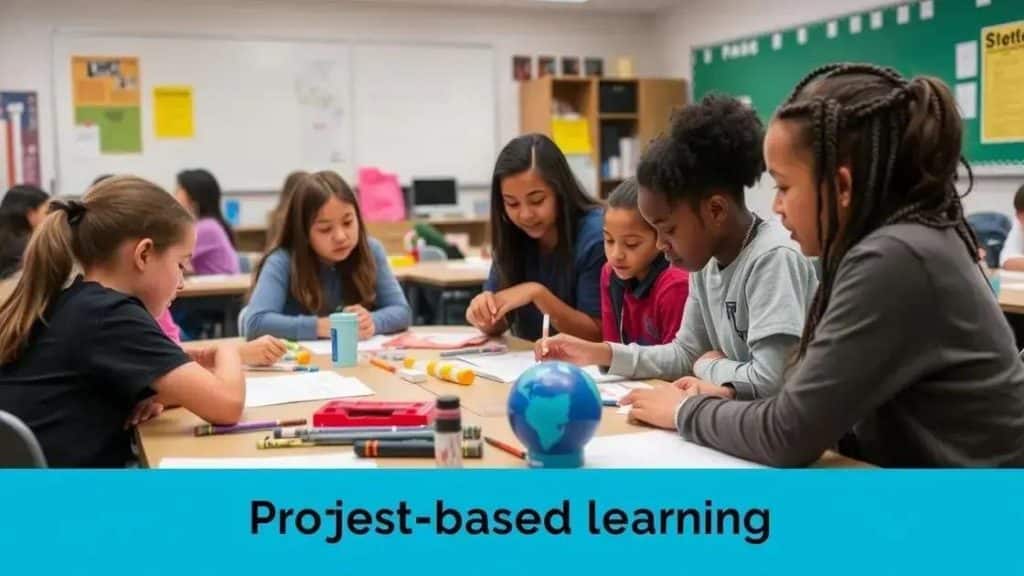STEM outreach programs: bridging gaps in education

STEM outreach programs engage students in science, technology, engineering, and mathematics, fostering interest and providing hands-on learning while focusing on inclusivity and community partnerships for future career readiness.
STEM outreach programs play a vital role in enhancing educational opportunities for students of all ages. They not only inspire young minds but also provide essential resources that enrich learning experiences. Want to know how these programs can make a difference in education? Let’s dive in!
Understanding STEM outreach programs
STEM outreach programs are essential in providing educational opportunities to students, especially those from underrepresented backgrounds. These programs encompass various initiatives that inspire interest in science, technology, engineering, and mathematics, collectively known as STEM. By engaging young minds, STEM outreach programs aim to cultivate curiosity and foster skills that are vital in today’s workforce.
Key Components of STEM Outreach Programs
Several elements contribute to the overall effectiveness of STEM outreach programs. Understanding these components can help schools and organizations design better initiatives.
- Collaborative Partnerships: Engaging with local businesses, universities, and community organizations enhances the reach and resources available.
- Hands-On Learning: Providing students with interactive activities allows them to apply theoretical knowledge practically.
- Mentorship Opportunities: Connecting students with mentors in STEM fields encourages them to pursue these disciplines in higher education.
- Diverse Curriculum: Incorporating a variety of topics within the STEM fields ensures broad interest and engagement.
The impact of these programs extends beyond immediate educational benefits. They pave the way for students to envision careers that they might not have considered otherwise. By creating inclusive environments, STEM outreach initiatives also help bridge gaps in education.
Moreover, programs often incorporate tech tools and digital resources that facilitate learning. For instance, coding workshops allow students to grasp fundamental programming skills. This exposure is crucial as tech-related careers continue to surge globally.
Real-Life Applications of STEM Learning
Integrating real-life applications into the curriculum can enhance the learning experience. Programs that focus on environmental science often involve projects that tackle local community issues, encouraging students to relate their studies to the world around them.
For many students, participating in STEM outreach not only boosts their academic performance but also builds confidence and valuable skills such as teamwork and problem-solving. These programs promote a mindset of innovation and creativity, essential traits for future leaders.
Key benefits of engaging in STEM programs
Engaging in STEM programs offers numerous benefits that can significantly enhance a student’s educational experience. These programs not only stimulate intellectual curiosity but also promote essential skills that are crucial for success in today’s technology-driven world.
Enhancing Critical Thinking Skills
One of the foremost benefits of participating in STEM programs is the development of critical thinking skills. Students are encouraged to approach problems analytically and creatively, which fosters a deeper understanding of the subjects they study.
- Problem-Solving Abilities: Students learn to identify problems and devise effective solutions.
- Analytical Skills: Engaging in data analysis helps students interpret and assess information.
- Creative Thinking: Innovative projects inspire students to think outside the box and explore unique solutions.
Moreover, STEM programs often incorporate real-world applications that make learning relevant and exciting. When students see how their studies apply in practical settings, their engagement levels skyrocket.
Opportunities for Collaboration
Another significant advantage of STEM outreach initiatives is the emphasis on collaboration. Students frequently work in teams, which teaches them essential interpersonal skills.
- Teamwork: Collaborating on projects encourages students to work effectively with others.
- Communication Skills: Sharing ideas and feedback hones students’ verbal and written communication abilities.
- Networking: Building relationships with peers and mentors can open doors for future opportunities.
Through these collaborative experiences, learners not only enhance their academic skills but also develop a sense of community and support. This environment helps students cultivate confidence and a sense of belonging.
The exposure to various technologies and methods used in STEM fields further equips students with skills that are highly sought after in the job market. Understanding how to use data-driven technologies, programming languages, and scientific tools prepares students for future educational pursuits and career opportunities. As they engage with cutting-edge tools, they become adept at navigating complex challenges.
How schools can implement STEM outreach

Schools play a crucial role in implementing STEM outreach programs effectively. By incorporating engaging and innovative strategies, they can inspire students to pursue interests in science, technology, engineering, and mathematics.
Building Community Partnerships
One effective method for schools is to establish partnerships with local businesses, universities, and community organizations. These partnerships can augment resources and provide real-world insights.
- Guest Speakers: Invite local professionals to share their experiences and knowledge.
- Field Trips: Organize visits to science centers or tech companies to see STEM in action.
- Internships: Create opportunities for students to gain hands-on experience in STEM fields.
These collaborations bring valuable expertise into the classroom, making STEM learning more relevant and exciting for students.
Creating Hands-On Opportunities
Another effective strategy is to develop hands-on learning experiences. Schools can implement projects that allow students to engage directly with STEM concepts.
- Science Fairs: Organize events where students can showcase their projects.
- Robotics Clubs: Encourage students to join clubs that focus on building and programming robots.
- Project-Based Learning: Introduce curricula that involve real-world problem-solving activities.
Project-based learning motivates students to delve deeper into STEM subjects. When students can navigate challenges, they gain confidence and valuable skills.
Additionally, schools should emphasize inclusivity in their STEM offerings. Ensuring that all students, regardless of background, can access STEM programs is essential. Offering scholarships, free workshops, and outreach in underrepresented communities will help bridge the gap.
Professional development for teachers is equally vital. Schools can provide training focused on the latest STEM education trends and technologies, enabling educators to deliver dynamic and relevant lessons.
Success stories from STEM initiatives
Success stories from STEM initiatives provide powerful examples of how effective these programs can be. They showcase the positive impact on students and communities and serve as inspiration for schools and organizations to adopt similar measures.
Case Study: Robotics Competitions
Many schools have participated in robotics competitions, leading to impressive results. For instance, a high school team that regularly competed in local and national robotics events improved their problem-solving skills and technical knowledge.
- Team Collaboration: Students learned to work together, enhancing their teamwork skills.
- Skill Development: Participants gained hands-on experience in programming and engineering.
- Community Recognition: Their achievements not only received awards but also recognition from local businesses and media.
This success motivated younger students to engage in STEM activities, creating a culture of innovation within the school.
Impact on Underrepresented Groups
Another inspiring story comes from programs aimed at underrepresented groups in STEM. A local initiative focused on girls and minority students provided dedicated workshops and mentorship.
- Increased Participation: Enrollment in STEM classes for these groups increased significantly.
- Scholarship Opportunities: Many participants received scholarships to pursue STEM education.
- Long-lasting Networks: Students formed valuable connections with mentors and peers.
As a result, several participants went on to study engineering and computer science, paving the way for future generations.
In addition to these stories, many schools have adopted project-based learning approaches, leading to successful outcomes. Students engaged in practical STEM projects often report greater enthusiasm for learning and more significant ownership over their education. This hands-on experience encourages them to explore career possibilities in STEM fields.
Future of STEM outreach in education
The future of STEM outreach in education looks promising as schools and communities recognize the importance of these programs. With technology evolving rapidly, integrating STEM initiatives is crucial for preparing students for future careers.
Embracing Technology
As technology advances, so do the methods of delivering STEM education. Schools are increasingly adopting digital tools to enhance learning experiences.
- Online Learning Platforms: These platforms provide access to resources and courses in various STEM subjects.
- Virtual Reality: VR can create immersive experiences, allowing students to explore scientific concepts in a more engaging way.
- Data Analytics: Educators use data to track student progress and tailor programs to meet individual needs.
These technological advancements not only make learning more interactive but also prepare students for technology-driven workplaces.
Focus on Inclusivity
Going forward, a significant trend is the focus on inclusivity in STEM outreach. Programs are being designed to ensure that students from diverse backgrounds have equal opportunities to engage with STEM education.
- Diverse Role Models: Highlighting successful professionals from varied backgrounds encourages students to see themselves in STEM fields.
- Targeted Outreach: Special initiatives aimed at girls and underrepresented communities can help close the gender and diversity gap.
- Scholarships and Grants: Financial support for underrepresented students promotes participation in STEM programs.
This commitment to inclusivity will foster a more diverse workforce, which is crucial for innovation.
Moreover, partnerships between schools and local industries will continue to grow, providing hands-on experiences that relate directly to real-world applications. Collaborative projects can help students understand how classroom knowledge translates into job skills. This connection between education and the workforce is vital for student motivation and career readiness.
Ultimately, as STEM outreach programs evolve, they will play a key role in shaping future generations of innovators and problem-solvers. By focusing on technological integration, inclusivity, and real-world applications, schools will prepare students to thrive in a dynamic world.
FAQ – Frequently Asked Questions about STEM Outreach in Education
What are STEM outreach programs?
STEM outreach programs are initiatives designed to engage students in science, technology, engineering, and mathematics, promoting interest and education in these fields.
How can schools implement STEM outreach effectively?
Schools can implement STEM outreach by building community partnerships, offering hands-on learning opportunities, and focusing on inclusivity to ensure all students can participate.
Why is inclusivity important in STEM education?
Inclusivity in STEM education helps to bridge the gender and diversity gap, encouraging underrepresented groups to pursue careers in these vital fields.
What is the future of STEM outreach programs?
The future of STEM outreach programs involves more technology integration, a focus on inclusivity, and strong community partnerships that prepare students for future careers.





